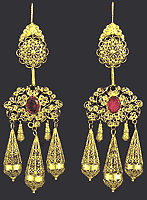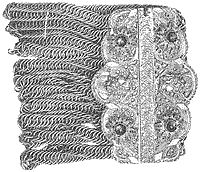  |

|

Fig. 12 Gold earrings with pearls from
Lefkada. Bridal earrings in which influences from neighbouring Italy
can be descerned, a general characteristic of the art of the Ionian
islands.
19th century
Athens, Benaki Museum, inv. no Exp 762.
|

Fig. 13 Gold filigree earrings with red
stones from Corfu. On the reverse is a ship, the emblem of Corfu.
The pendent 'teardrops' are a characteristic feature of the Ionian
Islands. Italian influences had been assimilated by the Epirote
goldsmiths who came to the Ionian islands during the 1821 War of
Independence.
19th century
Athens, Benaki Museum, inv. no Exp. 756.
|
|

Fig. 14 'Kordoni', an elaborate piece of
bridal jewellery from Attica. Silver gilt with rosettes set with
polychrome glass stones, miniatures and the bridegroom's
photograph.
Athens, Benaki Museum, inv. no Ea 1275.
|

Fig. 15 Bracelet from Attica.
Athens, Benaki Museum, inv. no Ea 280.
|
|

Fig. 16 Gilded jewellery from Attica.
Frontlet and kerchief-pins from the impressive Attica headdress and
the bridal pectoral ornament with hanging imitation, gold coins. The
ancient custom of women decorating the head is widespread, while the
decorative style of the works alludes to the Byzantine age.
19th century.
Athens, Benaki Museum inv. nos. Ea 273, 291, 292, 2134.
|
Easily carried and concealed, and wrought from precious
materials, jewellery was an ideal medium for saving and investment during the
Turkish Occupation. Conversely, for the very same reasons it was seized in
trouble times. The techniques used in working metals included engraving,
embossing - punching, repousse, hammering - casting, perforation and filigree,
often combined with granulation. Polychrome effects were achieved by setting
champleve - and niello (savati).
Greek jewellery can be classed into mainland and island
creations. The wide repertoire of enchanting themes includes ships with colorful
enamel sails, motifs from the plant and animal kingdoms, escutcheons, figures of
saints and of ordinary folk, pendent coins, mythical subjects and Neoclassical
traits. The result is distinguished by boundless imagination and regional
variation.
The `common' aesthetic conception of Greek jewellery complicates its study,
particularly with regard to determining its provenance (geographical
region-workshop) and date. Some help is obtained from other sources literature,
religious texts, notarial documents, foreign travelers' accounts, pictorial
works and oral tradition.
The systematic study of Neohellenic art has
developed apace in recent years, for not only is there an increasing awareness
of its important role in shaping contemporary Greek culture, but also an
appreciation of the value of its creations as models for the art of today.
Kate Synodinou
Archaeologist
Folk Art Section
Benaki Museum
|
|


|
Greece jewellery pages Copyright ©
by Add
Information Systems. (Greece)
|
|
  |

